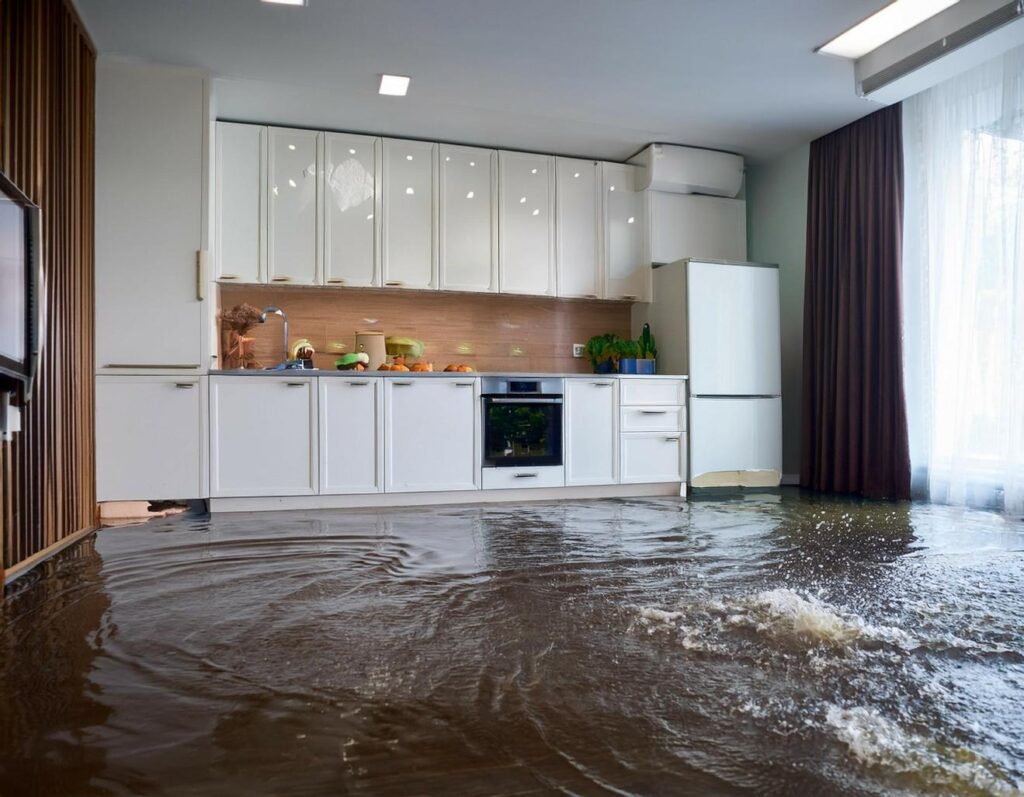
Contents
When flooding strikes your home, it’s vital to act quickly and methodically. Start by evaluating the damage and prioritizing safety, as standing water can pose serious hazards. You’ll need to document everything for insurance claims while wearing protective gear. Once you’ve secured your safety, effective water extraction methods will be your next focus. But there’s more to contemplate beyond just removing water; understanding the entire cleanup process is essential for successful recovery.
Key Takeaways
- Assess damage and ensure safety by wearing protective gear and documenting the situation for insurance claims.
- Utilize effective water extraction methods like sump pumps, submersible pumps, and water extraction vacuums.
- Implement drying and dehumidification techniques by using dehumidifiers, air movers, and monitoring humidity levels.
- Prevent mold growth by drying areas within 24-48 hours and cleaning surfaces with appropriate disinfectants.
- Consider professional flood cleanup services for efficient restoration and guidance on insurance claims and future prevention measures.
Assessing the Damage and Safety Precautions
When you’re faced with the aftermath of a flood, it’s essential to assess the damage thoroughly before diving into cleanup efforts. Start by wearing personal protective equipment, like gloves and boots, to ensure your safety as you navigate through potentially hazardous debris.
Conduct a meticulous damage evaluation; inspect walls, floors, and personal belongings for water saturation and mold growth. Check electrical systems and appliances, as water exposure can create serious safety hazards. Documenting the damage with photos helps for insurance claims later on.
Follow safety protocols by turning off utilities to prevent electrocution or gas leaks. If structural damage is apparent, avoid entering the premises until a professional can assess its integrity.
It’s a stressful time, but taking these steps can help you manage the situation effectively while ensuring your safety and that of your loved ones. By prioritizing safety, you set the stage for a successful cleanup ahead.
Water Extraction Techniques
When tackling water extraction after a flood, you’ll want to focus on effective techniques like pumping out water and using vacuum extraction methods.
Each approach has its strengths, and knowing when to apply them can make a significant difference in your home’s recovery.
Pumping Out Water
Start by evaluating the extent of the water damage in your home, as timely action is essential for effective recovery. Utilizing water removal techniques like sump pump usage can greatly aid in pumping out water. Here’s a quick comparison of methods:
| Method | Pros | Cons |
|---|---|---|
| Sump Pump | Efficient for large volumes | Requires electricity |
| Manual Pumping | Low cost | Labor-intensive |
| Submersible Pump | Portable and effective | Limited to specific areas |
| Trash Pump | Handles debris | Not suitable for clean water |
| Water Extraction Vac | Quick and thorough | Higher cost |
Vacuum Extraction Methods
After pumping out the majority of the water, vacuum extraction methods become essential for tackling the remaining moisture.
You’ll want to utilize effective suction techniques with portable vacuums designed for water extraction. These specialized vacuums can efficiently remove water from carpets, floors, and even hard-to-reach areas.
As you work, make sure you’re focusing on corners and crevices where moisture tends to linger, as this can lead to mold growth. Portable vacuums with robust suction capabilities can greatly speed up the drying process and minimize damage to your home.
Remember to check the vacuum’s capacity frequently to avoid overflow and ensure peak performance.
With careful attention and the right tools, you can effectively restore your space and protect your home from further issues.
Drying and Dehumidification Methods
Though maneuvering through the aftermath of a flood can feel overwhelming, effective drying and dehumidification methods are vital to restoring your home and preventing further damage. Start by selecting the right dehumidifier; it should match the size of the affected area and have a suitable capacity. Airflow optimization is paramount—ensure vents are unobstructed and use fans to circulate air efficiently.
Here’s a quick reference table for your drying strategy:
| Method | Description | Benefits |
|---|---|---|
| Dehumidifiers | Extract moisture from the air | Reduces humidity quickly |
| Air Movers | Circulate air to expedite drying | Enhances drying efficiency |
| Heat Sources | Increase the temperature to lower the humidity | Speeds up the drying process |
Cleaning and Sanitizing Affected Areas
After drying your home, it’s essential to assess the extent of the water damage to ensure that all affected areas are properly cleaned and sanitized.
You’ll need to disinfect surfaces thoroughly to eliminate any lingering contaminants and prevent mold growth, which can pose serious health risks.
Taking these steps restores your living space and safeguards your family’s well-being.
Assessing Water Damage
As you begin to assess water damage in your home, it’s essential to prioritize safety and clarity in your evaluation. Start by documenting affected areas and checking for structural integrity. Here’s a quick reference table to guide you through the process:
| Damage Type | Indicators | Action Needed |
|---|---|---|
| Surface Damage | Warping, discoloration | Inspect and document |
| Structural Damage | Cracks, sagging ceilings | Consult a professional |
| Electrical Issues | Exposed wires, tripped circuits | Shut off power, contact pros |
Don’t forget to check your flood insurance policy and reach out to your emergency contacts. Proper assessment ensures you address issues promptly, minimizing long-term damage and protecting your home.
Disinfecting Surfaces Thoroughly
Once you’ve assessed the water damage, it’s vital to tackle the cleanup with a thorough disinfection process.
Start by gathering effective disinfecting agents, such as bleach or hydrogen peroxide, which can eliminate harmful bacteria and viruses. When applying these agents, make sure you follow the manufacturer’s guidelines for dilution and contact time.
Focus on all affected surfaces, including walls, floors, and furniture, using a scrub brush or cloth to scrub away contaminants. After disinfecting, rinse surfaces with clean water to remove any residue.
For the best surface sanitization, allow areas to dry completely, as moisture can lead to further issues.
Preventing Mold Growth
To effectively prevent mold growth in your home after a flood, it’s crucial to act quickly and methodically.
Begin by thoroughly drying all affected areas within 24-48 hours, as mold spores thrive in damp environments. Use fans, dehumidifiers, and open windows for moisture control.
Remove any wet materials, like carpets or drywall, that can’t be dried completely. Clean surfaces with a solution of water and detergent, then sanitize with a mixture of bleach and water to kill any remaining spores.
To minimize humidity, ensure proper ventilation in your home and regularly check hidden spots, such as behind appliances and in basements, for signs of moisture.
Taking these steps will greatly reduce the risk of mold growth and protect your health.
Mold Prevention and Remediation
If you want to protect your home from the damaging effects of mold after a flood, it’s vital to act quickly and effectively.
Mold thrives in damp conditions, so understanding mold growth conditions is key. Here are some effective mold prevention and remediation steps:
Identify Moisture Sources: Use mold identification techniques to spot areas where water may accumulate.
Dry Out Affected Areas: Utilize fans and dehumidifiers to reduce humidity levels and dry surfaces.
Clean Thoroughly: Use a mixture of water and detergent on surfaces; consider specialized mold removers for stubborn growth.
Seal and Insulate: Seal any leaks and insulate pipes to prevent future moisture infiltration.
Repairing Structural Damage
Repairing structural damage after a flood is essential for restoring your home’s safety and integrity. You’ll want to assess the extent of the damage carefully. Start with visible areas like walls and foundations, then look for hidden issues in beams and joists. Utilizing effective repair techniques can help maintain your home’s structural integrity.
| Area of Damage | Common Repair Techniques | Recommended Materials |
|---|---|---|
| Walls | Patching, reinforcement | Drywall, adhesive |
| Foundation | Underpinning, sealing cracks | Concrete, epoxy |
| Roof | Shingle replacement, sealing | Asphalt shingles, tar |
| Floors | Joist replacement, leveling | Plywood, leveling compound |
Addressing these issues promptly can prevent further deterioration. If you’re unsure about the repairs, consult a professional to verify that your home is safe and sound. Your peace of mind depends on it.
Salvaging Personal Belongings
After addressing structural damage, the next important step is salvaging personal belongings affected by the flood.
You’ll want to act quickly to maximize your chances of successful personal item restoration and sentimental value preservation.
Here’s how you can approach it:
Assess Damage: Carefully inspect each item for water damage. Prioritize items that hold significant emotional value.
Clean and Dry: Rinse items with clean water, then dry them thoroughly. Use fans and dehumidifiers to expedite the process.
Store Properly: For items that can’t be restored immediately, store them in a climate-controlled environment to prevent further damage.
Seek Professional Help: If you’re unsure about restoration, consider consulting experts who specialize in salvaging valuables.
Utilizing Professional Flood Cleanup Services
When floodwaters have wreaked havoc on your home, enlisting professional flood cleanup services can greatly alleviate the burden. These experts bring specialized equipment and techniques to quickly remove water, dry affected areas, and prevent mold growth. They understand the urgency of your situation and work efficiently to restore your home.
Moreover, professional services can help you navigate the complexities of flood insurance claims. They often document the damage thoroughly, providing you with the necessary information to support your claim and fulfill your homeowner responsibilities.
This ensures you receive the compensation you’re entitled to and alleviates some of the stress during a challenging time.
Implementing Flood Prevention Measures
Recovering from a flood can be overwhelming, but taking proactive steps to implement flood prevention measures can save you from future devastation.
Start by adopting these effective strategies:
Landscape Grading: Ascertain your yard slopes away from your home. This redirects rainwater and prevents pooling around your foundation.
Rainwater Harvesting: Install rain barrels to collect rainwater from your roof. This will conserve water and reduce runoff and pressure on drainage systems.
Gutter Maintenance: Regularly clean and inspect your gutters and downspouts to prevent blockages that can lead to overflow.
Flood Barriers: Consider installing flood barriers or sandbags around your property during heavy rain forecasts.
Recap
So, you’ve turned your home into a swimming pool—how charming! But before you start charging admission, remember to tackle the cleanup with methodical precision. Your soggy carpet and moldy walls won’t fix themselves, and neither will your sanity. Embrace the chaos, don your protective gear, and take charge. After all, who wouldn’t want a personal adventure in water extraction? Just remember, a little preparation could’ve saved you from your new role as a reluctant amphibian.
Recent Posts
Master Flood Recovery: Test Your Water Removal Skills
Many people underestimate the complexity of flood recovery, often thinking it’s just about removing water.
Why Is Emergency Water Removal Crucial After Flooding?
When flooding occurs, emergency water removal is vital to mitigate serious health risks and property
Quick Tips for Post-Flood Water Removal
After a flood, knowing how to act quickly can make a big difference. You need
